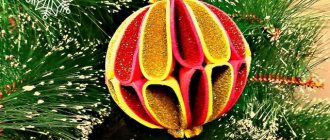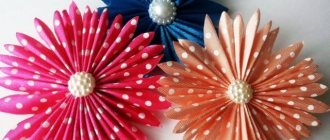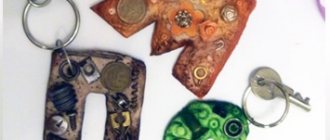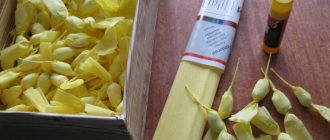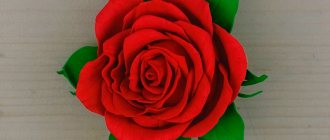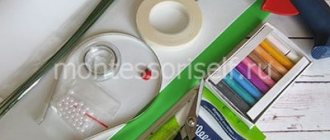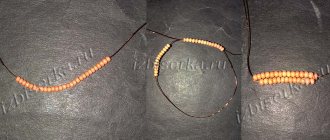How to make a small rose from marshmallow foamiran: sepal pattern, photo
Marshmallow foamiran requires a more careful approach and different processing
We prepare patterns:
- 6 petals of three different sizes, 2 each. each, purple
- 3 leaves and sepals from green foamiran
Blanks for creativity
- Iron the foamiran templates through a sheet of paper with a warm iron
- Forming indentations at the bottom of the petals
- Then we heat the edges with an iron and tighten them, making them wavy.
- For medium and small workpieces we make rollers and tucks on all sides
- We fold the sepals into one leaf and gently twist the edges and pull them out a little.
- Using foil, we prepare the base for the flower like a cone.
- Next we paste over 3 layers of tiny petals, masking the foil
- All rows should be at the same height; if necessary, tighten short petals
- We arrange each petal trying to close all the holes (like chess)
- We continue gluing medium and then large pieces, pulling them tightly to the base and coating them well with glue.
Final stage
About the material
Foamiran is a velvety looking and touching material with a foamed structure. The polymer contains vinyl acetate and ethylene. These substances cause sheets of plastic suede to have a pungent odor while they are packaged.
The production of foamiran started in Iran. Gradually, it was adopted by entrepreneurs from China and other countries. Due to its ease of processing and variety of uses, revelur quickly became popular. Its main advantage is flexibility. The material softens and becomes ready for use under the influence of low temperature, for example, the warmth of human hands.
You can buy foam rubber at any craft store. More often you can find sheet foam, the standard size is 40 x 60 cm. The thickness of the plates varies, depending on the manufacturer, does not exceed 3 mm. Roll form is also possible. Thin sheets are sold rolled up without packaging.
The flexibility and ductility of the material increases due to the degree of foaminess. Quality determines ease of use. The more air bubbles there are in it, the easier it is to roll out and pull out different shapes after heating.
How to make a Yin-Yang rose from foamiran: pattern, diagram, photo
A beautiful symbol of love can be easily made at home.
Basis for creativity
Hair band
A headband with flowers made of foamiran will become an exquisite accessory for every fashionista. To make the decoration you will need ready-made flowers, leaves, glue, and a headband. The algorithm for creating an original craft is quite simple. It is enough to glue the leaves and selected flowers to the rim. Carefully secure the composition. You can decorate with beads and sprigs of greenery.
How to make a bouquet of roses from foamiran: step-by-step diagram, photo
Step-by-step scheme of workTopiary
Topiary is an original craft, an excellent gift option, desktop decoration, or home interior. Algorithm for creating a tree from foamiran in accordance with photo diagrams:
The photo shows how to make topiary from foamiran:
The most beautiful roses from foamiran: photo
Delicate decoration for a wedding
Properties and Application
Foamiran quickly became so popular due to its convenient release form, variety of colors, low price and its unique properties. It is significantly superior to fabric or paper and is suitable for creating flat crafts, three-dimensional shapes, and flowers. The decorative material has the following features:
- It becomes soft under the influence of the warmth of your hands and the flame of a candle. Greater plasticity can be achieved by attaching the element to a battery or iron;
- Keeps its shape well after cooling. Crafts become durable and do not deform when touched or dropped;
- Foam rubber can be made strong or stretched by applying various heat sources;
- Products made from foamiran can be tinted in various ways. To give a natural shade to flower petals, pastel crayons and acrylic paints are used;
- Plastic suede can be cut with ordinary scissors or a stationery knife;
- To connect several parts, use strong adhesive, a hot gun with a glue stick.
Foam is used to create various crafts, both flat and three-dimensional, decorate simple objects, and decorate interiors. You can use small flowers to cover the edge of a clock on the wall or a photo frame. If you collect rubber petals in the form of a dome, you will get an excellent lampshade for a lamp. Foamiran is also used to make fashionable jewelry, decorative dolls, gift vases, baskets with stunning bouquets of roses, peonies or assorted flowers.
Definition of terms
1.1 The following terms are used in this Privacy Policy:
1.1.1. “Site Administration” (hereinafter referred to as the Administration) - authorized employees to manage the site Online store of materials for creative work, acting on behalf of individual entrepreneur A.A. Dolzhenkov, who organize and (or) carry out the processing of personal data, and also determines the purposes of processing personal data, composition of personal data to be processed, actions (operations) performed with personal data.
1.1.2. “Personal data” - any information relating to a directly or indirectly identified or identifiable individual (subject of personal data).
1.1.3. “Processing of personal data” - any action (operation) or set of actions (operations) performed using automation tools or without the use of such means with personal data, including collection, recording, systematization, accumulation, storage, clarification (updating, changing), extraction, use, transfer (distribution, provision, access), depersonalization, blocking, deletion, destruction of personal data.
1.1.4. “Confidentiality of personal data” is a requirement for the Operator or other person who has access to personal data to comply with the requirement not to allow their distribution without the consent of the subject of personal data or the presence of another legal basis.
1.1.5. “Website Internet store of materials for creativity” is a collection of interconnected web pages located on the Internet at a unique address (URL): esel.by, as well as its subdomains.
1.1.6. “Subdomains” are pages or a set of pages located on third-level domains belonging to the website of the Internet store of materials for creativity, as well as other temporary pages, at the bottom of which the contact information of the Administration is indicated
1.1.5. “User of the site Internet store of materials for creativity” (hereinafter referred to as the User) is a person who has access to the site Internet store of materials for creativity via the Internet and uses the information, materials and products of the site Internet store of materials for creativity.
1.1.7. “Cookies” are a small piece of data sent by a web server and stored on the user’s computer, which a web client or web browser sends to the web server each time in an HTTP request when an attempt is made to open a page on the corresponding site.
1.1.8. “IP address” is a unique network address of a node on a computer network through which the User gains access to Elena Studio.
1.1.9. “Product” is a product that the User orders on the website and pays through payment systems.
Dispute Resolution
8.1. Before filing a claim in court regarding disputes arising from the relationship between the User and the Administration, it is mandatory to submit a claim (a written proposal or an electronic proposal for a voluntary settlement of the dispute).
8.2. The recipient of the claim, within 30 calendar days from the date of receipt of the claim, notifies the claimant in writing or electronically of the results of consideration of the claim.
8.3. If an agreement is not reached, the dispute will be referred to the Arbitration Court of Vitebsk.
8.4. The current legislation of the Russian Federation applies to this Privacy Policy and the relationship between the User and the Administration.
Small unopened bud
If you want to try your hand, but starting with large projects is scary, take note of a simplified method for creating roses. In this MK, the tools and materials are similar to the previous versions, and you will make the base of the flower from ordinary foil.
The result of the work is a closed, goblet-shaped bud that will decorate a hairpin, barrette or hair tie.
Tips for beginners
Fiamiran is not the easiest material to work with. Many may think that making a rose out of it is unrealistic. However, it is not. Yes, many petals and leaves can break when twisted, so beginners are advised to prepare a larger number of these elements in advance. This material is best attached to workpieces if the master uses glue
It is important to wait until it is completely dry before moving on to the next stage of work. Sometimes after drying the glue is too visible on the elements of the rose. You should not try to peel it off, as this can damage the composition.
To hide traces of glue, it is enough to mask the flower element, where it exists, with another element. For example, you can move another one onto one petal with glue so that the glue becomes invisible.
Tips for beginners
Fiamiran is not the easiest material to work with. Many may think that making a rose out of it is unrealistic. However, it is not. Yes, many petals and leaves can break when twisted, so beginners are advised to prepare a larger number of these elements in advance. This material is best attached to workpieces if the master uses glue
It is important to wait until it is completely dry before moving on to the next stage of work. Sometimes after drying the glue is too visible on the elements of the rose. You should not try to peel it off, as this can damage the composition.
To hide traces of glue, it is enough to mask the flower element, where it exists, with another element. For example, you can move another one onto one petal with glue so that the glue becomes invisible.
General provisions
2.1. Use of the website by the Online Store of Creative Materials by the User means acceptance of this Privacy Policy and the terms of processing of the User’s personal data.
2.2. In case of disagreement with the terms of the Privacy Policy, the User must stop using the website. Online store of materials for creative work.
2.3. This Privacy Policy applies to the website Online Store of Creative Materials. Elena Studio does not control and is not responsible for third party sites that the User can access via links available on the website of the Online Store of Creative Materials.
2.4. The Administration does not verify the accuracy of the personal data provided by the User.
Peony option
If the previous method of forming a flower seemed too complicated to you, pay attention to this master class. By following the step-by-step instructions, you can create a beautiful peony rose.
Necessary materials:
- foamiran (yellow, preferably two shades, and green);
- sharp scissors;
- glue gun;
- wire;
- thick hook;
- ball on the handle;
- thick foam rubber covered with dense, lint-free material.
The first step is to prepare the petals and leaves. You can use a cardboard template, or you can immediately cut them out of foamiran. A slight difference in the shapes and sizes of the blanks will only add realism to the product. We cut out 12 of the smallest petals in the main color and 6 in another shade of yellow. If you do everything only in yellow, it’s okay.
Now you can give the blanks a natural shape. Place all the petals, except the largest ones, one by one on a heated iron. Place the hot plastic piece on the foam rubber and press it in the middle with a hook.
Heat large petals in the same way, place them on foam rubber and roll them with force into a ball. If you don’t have such a ready-made tool, you can attach a large bead to a wooden skewer or knitting needle.
Place the sepal on a toothpick and place it on the iron. The tips of the petals should curve slightly.
We evaluate the result.
Take a thin wire. Cut 4 pieces, bend a small loop at the end of each.
Glue 3 small petals onto each wire. Their edges should face the same direction.
Now glue 4 petals of the following size onto these blanks.
Form the third layer by gluing 3 more petals onto each piece.
Twist the pieces in pairs.
Twist the resulting blanks again into one common center of the flower.
Glue the bottom in a circle, first 4 darker ones, and then light petals. Next, fix the largest ones, each new petal should half cover the previous one. Lastly, attach the sepals.
To make the flower more realistic, add small bright petals to the middle of the rose using a toothpick.
If you want to achieve perfection, you can slightly tint the edges of the petals with yellow (use dry pastel or acrylic paint).
The masterpiece is ready. You can add leaves to the rose, attach a pin to it and use it as a brooch, or glue it to a hairband. The choice is yours.


